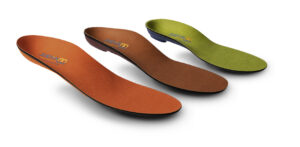
Instructions for use
Only place your Jurtin insoles in suitable shoes, shoes with removable footbed are particularly suitable. Please bring your most frequently used shoes with you, when you visit your Jurtin specialist.
Always wear the orthopedic insoles with stockings and check your feet for redness, pressure points or skin changes daily and report to your Jurtin specialist or doctor immediately if necessary.
Please have the Jurtin orthotics checked regularly by your consultant. If the orthopedic insoles are worn out, the function is no longer given. The load capacity of the insoles is adjusted to the expected load at the time of fitting. Improper use can lead to material fatigue due to strain and, in extreme cases, to the destruction of the insoles.
Avoid the use of the insole in water, unless specifically constructed for this purpose, and avoid contact with acids and solvents. Any heating of the insoles above 50°C must be avoided, because this can lead to changes in properties and fit. The insoles must also be kept away from open flames.
The daily time for wearing them is to be coordinated with your doctor according to your personal therapy concept. Your insoles are marked with “L” for left and “R” for right. Place the insoles in your shoes according to this indication so that the heel cups rest against the heel frame of the shoe. Heel cups glued into the shoe must be removed when using an insole to allow for proper positioning of the insole. When stepping into the shoe, be sure to open the shoes wide enough so that the toes do not claw when stepping in. As a rule, the general service life is at least 6 months. This can also be shorter or longer depending on the influencing factors such as frequency of use, gait pattern, weight, etc.).
Purpose of the product/indication
The insoles are intended for the following purposes/indications:
Support for ligament or muscle slackening, when the natural arch structure is gone. Bedding for painful stress disorders of the ligaments and pathologically altered ankles.
Soft cushioning to avoid pressure peaks all over the foot without correcting the foot.
Permissible conditions of use/locations
When selecting shoes, pay attention to the following points:
- The insole is designed for a specific actual heel height. Actual heel height refers to the difference in height between the thickness of the sole in the heel area and the thickness of the sole in the forefoot area. If the effective heel of the shoe is too high, this causes the insole to tilt in the shoe, which in turn causes the heel to slip out of the shoe. If the effective heel is too low, this leads to a relative exaggeration of the longitudinal arch and thus to space problems in the shoe.
- A high heel always leads to increased stress in the forefoot. In the case of overuse complaints in the forefoot area, it is therefore advisable to carry out the insole fitting in shoes with lower heels.
- The heel cup of the shoe must be designed high enough to prevent the heel from slipping out. Always test the heel fitting with an insole so that the thickness of the insole is taken into account.
- Loafers are usually inconvenient because, on the one hand, the entry opening is too small and, on the other hand, the shoe does not provide enough space for the foot and the insole. Shoes with adjustable closures are adjustable and usually more suitable. These closures should only be closed so far that an additional pressure on the back of the foot arises. Make sure that there is also enough free space for the foot and insole in the toe area.
- Bedding insoles often make special demands on the shoe, which can sometimes only be realized in custom-made products. Your Jurtin consultant will advise you personally.
- For children and adolescents, feet growth must be taken into account, since an orthopedic insole that is too small will not fulfill the required medical benefit.
Jurtin insoles may only be worn in safety shoes if they comply with the specifications of ÖNORM/DGUV Rule 112-191, otherwise the manufacturer’s liability is not guaranteed!
Only orthopedic insoles approved by the manufacturer of the safety shoes by means of a type examination may be worn in safety shoes.
Existing application risks and contraindications
Application risks and contraindications may be:
Skin redness due to allergic reactions.
Cleaning instructions
After each use of the insoles, you should remove them from the shoe for airing and drying. If the insole has become too damp/wet, remove it from the shoe and allow it to dry at room temperature. Please DO NOT dry the insole with heat sources, such as oven, hair dryer or heater.
Please DO NOT wash your insoles in the washing machine. Our recommendation: For a for a professional cleaning please use the Jurtin Cleaner and the Jurtin Freshness Kick.
Maintenance instructions
Observe the maintenance interval specified by your specialist company. We recommend a follow-up check of the insoles after approx. 6-8 weeks and an annual check.
If the material shows signs of wear, please contact your specialist company as soon as possible. In general, pay attention to material fatigue; it should be renewed or replaced timely if necessary.
Materials used
For the production of insoles are used materials such as EVA, microfiber,
thermoplastics (PE), plastics or resins of polyurethanes (PU), fiber composites (e.g. carbonized plastics (FVW)) are used. The processed materials differ according to the model and type of the manufactured inserts.
In case of any ambiguities, problems or deficiencies of the shoes, contact your orthopedic shoemaker.